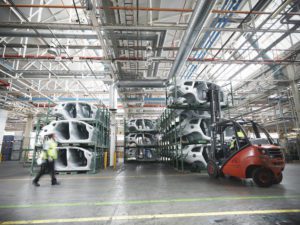I am a strong believer in the coming of the Internet of Things. In some areas it is already here, not in its final form but in its infancy. Considering the vast amount of information the Internet of Things will make available to the industrial automation system user it becomes obvious the access to this information will have to change. The way we use the industrial automation information will have to evolve as the Internet of Things forces the evolution of these systems.
The amount of data presented to the user of an industrial automation system is increasing and will continue to increase. The data is dynamic with different types of users interested in different parts of this data. The interface to the data has to be just as dynamic. The traditional Human Machine Interface (HMI) has too many limitations to be effective.
The HMI is in a fixed location running software with little flexibility, talking to the PLC and the PLC talks to the rest of the industrial network. There is a need for specialized skills for maintenance and operation. When there is an issue on the line the HMI is not where the issue is located.
So, what do we do with the HMI?
We look at common portable technology available today and adapt that to our new HMI. Tablet devices are the obvious first choice. Tablets are portable with flexible software that can be adapted to the needs of the user. You download the HMI application of your choice from Schneider Electric app store or the Apple Store or elsewhere then tailor the application to your personal preferences. The HMI goes with you everywhere in the plant; you will have it near the source of any issues. As the need of the user changes such as from supervisory to maintenance then the user picks a different application to look at the data from another aspect. Using the camera and other features, the user captures video/audio/verbal evidence of the problem while the problem is happening. The failure information is sent to proper persons for analysis. Reset the system then it is back to supervisory mode.
Is your next HMI in your pocket now?
Your smart phone has all the resources to function as an HMI. You already know how to use it. It is more portable than a tablet with less utility but essentially same. The HMI applications can be sharable between the tablet and your smart phone. Wearable enhancements could be added to your smart phone to make interaction seamless. The technology exists today. A wearable HMI can be based on work done at MIT in the form of Sixth Sense project. Here a smart phone is the basis for a computer system that includes a projector to make any surface into a display. The Google Glass is an obvious choice for an HMI, making the HMI into a pair of glasses.
The technology exists today to transform the HMI into a better tool for the user that has the flexibility to keep up with the changing industrial automation system.
What technology will you use to build your next HMI?




Conversation
Nice one Todd!
Human Machine Interface is really important for humans to interact with any kind of machine. HMI is the technology because of which we can use all the features of Automation and other technologies including Industrial Automation.
Thank you Divya,
As we hide the complexity of the underlying automation network from the user and simplify the programming, the HMI will become even more important. Using the emerging technologies available for the HMI will make this evolution possible.
HMIs will just get better with each passing year I guess. Few years from now, I think almost every appliance (including TVs, refrigerators and microwave ovens and not just industrial systems) will a design adapted to HMIs. Right now, it might seem a bit like science fiction but there’s a good chance that HMIs will help us control nearly everything mechanical, electrical or electronic with our smart phones, tablets etc. If that’s how it’s going to happen in homes and offices, you can image what might happen in laboratories, schools and factories where even advanced technological applications are likely to be deployed.
Joe, your comment is true. The HMI is already in many of the appliances offered by some of the most common manufacturers. General Electric has their Brillion line, Whirlpool with their Sixth Sense Live appliances and Samsung have their Smart Control Appliances all of which have a form of HMI. I am sure there are other manufacturers with similar support. Further these appliances can be accessed by one’s cell phone through the appropriate company application. If one carries a smart phone then she or he has a potential HMI for any appliance or device provided the device has the ability to be accessed and the interesting information can be made available. Of course there is the problem of “what is the interesting information?”. That will be different for each user, what is interesting to me may not be interesting to you. If I am fixing or providing maintenance to the appliance I need different information than the user. I can imagine any electrical device having sharable HMI data, not necessarily a physical HMI, being accessed by the HMI in your pocket. That is your smart phone with appropriate application. The appliance application will be available at a URL supplied by your appliance in the documentation or on an information plate on the appliance. You download the app to your phone and tailor the app to see your desired information. The generation in colleges and schools now will come to expect it.
Good Information, Thanks For Sharing.